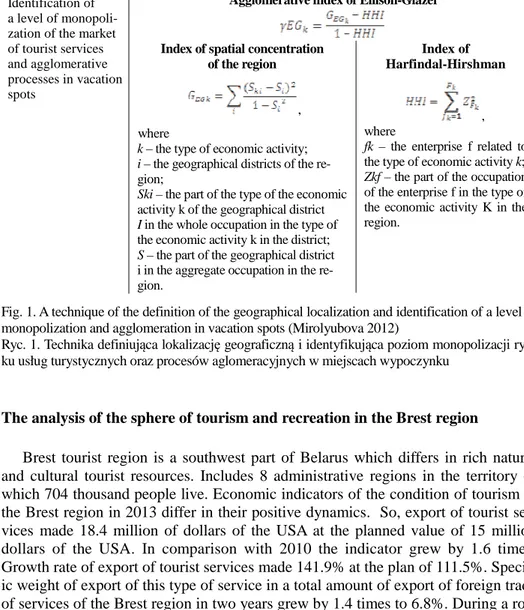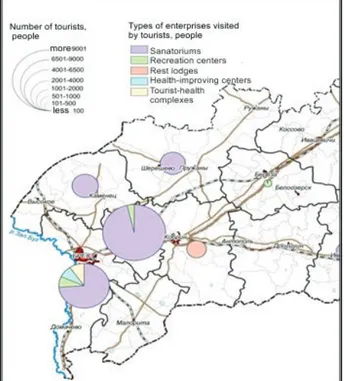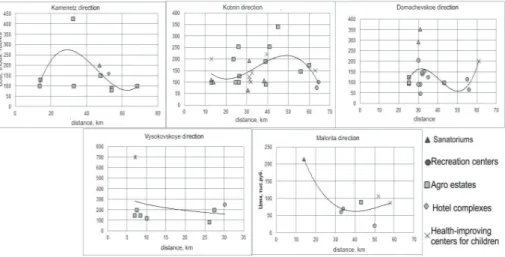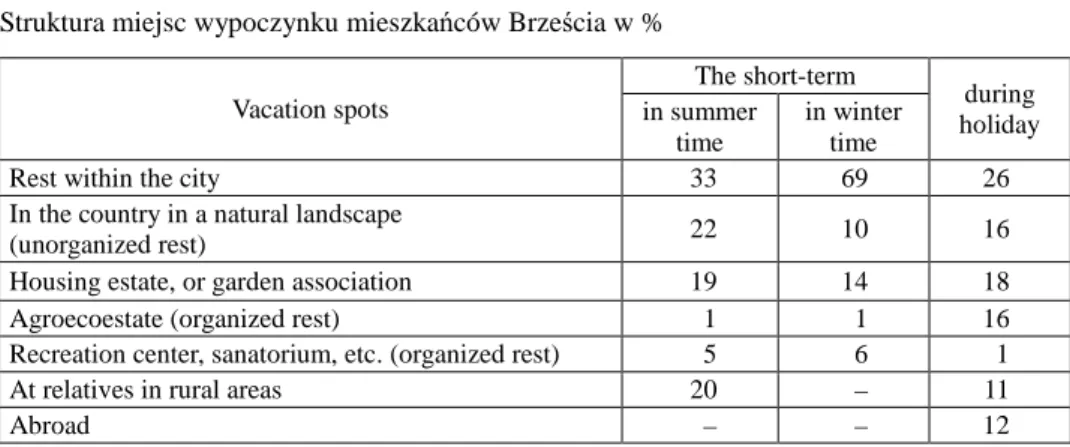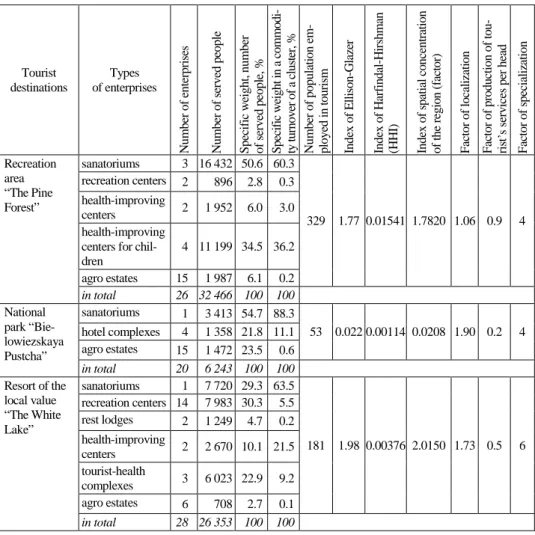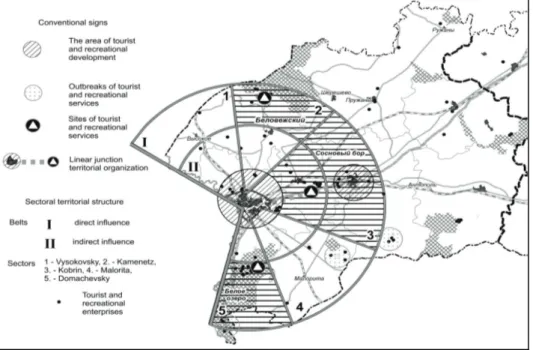S ł u p s k i e P r a c e G e o g r a f i c z n e 12 • 2015
Denis V. Nikityuk
Konstantin K. Krasovsky Brest State University
Brest
denikityuk@gmail.com
FORMATION OF THE BREST REGIONAL
TOURIST CLUSTER
KSZTAŁTOWANIE SIĘ BRZESKIEGO REGIONALNEGO
KLASTRA TURYSTYCZNEGO
Zarys treści: In the article the territorial reflection of allocation of a regional cluster is
con-sidered. As a basis of the research the concept of a cluster as a branch of the geographical agglomeration was used. The technique of allocation of a regional cluster as the example of the Brest region (Belarus) is offered and approved.
Key words: tourist region, cluster, agglomeration, tourist destination, regional tourist cluster
Słowa kluczowe:region turystyczny, klaster, aglomeracja turystyczna, regionalny klaster turystyczny
Introduction
Tourism and recreation represent the integral element of the social and economic de-velopment of regions. Currently, tourism and recreation not only provide the restoration of psychophysical forces of the population and promote the increase of cross-cultural communications, but also are the independent branch of the economy providing the development of the centers, and peripheral zones of regions. Tourism and recreation act as the largest land user who uses the most valuable land resources (natural and cul-tural landscapes) from the ecological and economic points of view. Besides land re-sources, an important role is played by such factors of production of tourist services as the manpower, the capital of the region, the investment, the innovations, and also the character of the arrangement according to the main interregional and internation-al centers of demand. The whole set of factors of production of the regioninternation-al tourist product is reflected in its competitiveness. The effective form of the territorial organiza-tion of the enterprises of the industry and tourism infrastructure is necessary for the
creation or the increase of competitiveness of the regional tourist product. In the ter-ritory of The Republic of Belarus during the Soviet stage of the development the spatial organization of the enterprises of a tourist and recreational complex is con-sidered as result of the formation of the territorial recreational system (TRS). The most important scientific works concerning the territorial organization of tourism and rec-reation during the Soviet and Post-Soviet periods belong to I.I. Pirozhnik (Pirozhnik 1985, 2008). TRS of Belarus had the territorial embodiment reflected in tourist and recreational division into districts. Currently, 18 tourist and recreational areas (Pi-rozhnik 1985, 2008) (tourist regions) are allocated in Belarus, in which internal pro-cesses of territorial differentiation of the tourist product are observed, that is caused by the emergence of intradistrict destinations. Territorial differentiation leads to emergence of the internal competitive environment and strengthening of competitive positions of the separate enterprises and their agglomerations at the regional and in-ternational market of tourist services. At present geographical agglomerations of the enterprises of tourism and recreation are a source of the competitive advantage of the region due to the economy from the measure of production (Krugman 1991; Lindqvist 2009). According to M. Porter, treat sources of competitive advantages of regions are: “the related and supporting branches”, “the conditions for factors”, “the con-text of the strategy and the rivalry”, “the conditions of the local demand” (Porter 2003). The competitive advantage “the related and supporting branches” under certain con-ditions M. Porter considers as a cluster (Porter 2006). The geographical community of an arrangement and interrelation of the enterprises on the basis of interaction act as conditions. A little differently the term “cluster” treats M. Enright, focusing attention on the spatial process of the agglomeration and the competition of the enterprises. In the concept of “a regional cluster” of M. Enright “the cluster is a geographical ag-glomeration of the firms working in one or several related branches of economy” (En-right 1996). In case of the tourist region the cluster of enterprising initiatives should be considered as a set of the same, or identical enterprises of the small and medium busi-ness which are competing among themselves for factors of production and product markets, but having a common goal – strengthening of the appeal of the region or the separate destination. In a situation in which within one tourist region there are some destinations, the system of relationship between the enterprises becomes more compli-cated due to the competition between destinations. The objectives as “the strengthen-ing of the appeal of the region” are achieved by the implementation of joint events, the infrastructure, the investment and other projects. In this work we will consider the op-portunity of the formation of the tourist regional cluster in the Brest tourist region.
The sources of competitive advantages of the region marked out by M. Porter have the territorial refraction and are expressed in factors of the placement, the territo-rial competition, the territoterrito-rial organization of the enterprises of a tourist and recrea-tional complex (cluster) and their consumer markets. Therefore, the cluster as a source of regional competitiveness is a derivative element of the territorial organization of a society. The regional tourist cluster represents a communication form (rivalry and/or cooperation) of a set of the enterprises of the small and medium business making the same production (services) concentrated round one consumer, scientific, industrial center in the space limited by the regional borders. The regional tourist cluster is formed in centro-peripheral system of the region as the result of a process of polarization of its
economic space, but thus forms genetic linkages with the big city (number of the pop-ulation more than 100 thousand people). The big cities act as the center of demand, the territorial administration, the training and distribution of innovations.
Research technique
Separation of a regional cluster as the new form of the territorial organization of tourism and recreation is the most proved to make on the basis of results of the anal-ysis of statistical data.
At the first stage a task is definition of a state and tendencies of development, namely the growth in the sphere of tourism and recreation of the region. The analy-sis of a tourist branch of the region is necessary, for which the indicators of export and import of tourist services, the number of visits, the structure of employment of the population and the volume of financial means from tourism which came to the region and their territorial differentiation are used for this concrete purpose. For the estab-lishment of recreational selectivity of locals sociological examination was conducted. The technique of allocation of tourist clusters is based on methodology of social and economic geography and includes the tasks presented in Figure 1. For determi-nation of the amount of the most intensive contacts within a market zone of the big city we use an indicator of an intensity of trade streams (Fam) (from gravitational model of V. Rayleigh (Reilly 1931)).
Object Indices
The definition of the market localization of the enterprises of tourism and recreation
Localization coefficient
where ij – the number of occupied in j-sector i-region; it – the general number occupied in i-region;
nj –the number of occupied in j-sector in the country in tote; nt – the general number of occupied in the country. Specialization coefficient
where Yo – the specific weight of the region in the country according to this branch;
Yp – the specific weight of the region in the country according to the whole branch.
Coefficient of per head production
, where Dj – the commodity circulation per head of the j-region;
Dj – the medium commodity circulation per head according to all regions; Sj – the number of the population of the j-region;
Identification of a level of monopoli-zation of the market of tourist services and agglomerative processes in vacation spots
Agglomerative index of Ellison-Glazer
Index of spatial concentration of the region
Index of Harfindal-Hirshman
, where
k – the type of economic activity; i – the geographical districts of the
re-gion;
Ski – the part of the type of the economic
activity k of the geographical district
I in the whole occupation in the type of
the economic activity k in the district;
S – the part of the geographical district
i in the aggregate occupation in the re-gion.
, where
fk – the enterprise f related to
the type of economic activity k;
Zkf – the part of the occupation
of the enterprise f in the type of the economic activity K in the region.
Fig. 1. A technique of the definition of the geographical localization and identification of a level of monopolization and agglomeration in vacation spots (Mirolyubova 2012)
Ryc. 1. Technika definiująca lokalizację geograficzną i identyfikująca poziom monopolizacji ryn-ku usług turystycznych oraz procesów aglomeracyjnych w miejscach wypoczynryn-ku
The analysis of the sphere of tourism and recreation in the Brest region
Brest tourist region is a southwest part of Belarus which differs in rich natural and cultural tourist resources. Includes 8 administrative regions in the territory of which 704 thousand people live. Economic indicators of the condition of tourism in the Brest region in 2013 differ in their positive dynamics. So, export of tourist ser-vices made 18.4 million of dollars of the USA at the planned value of 15 million dollars of the USA. In comparison with 2010 the indicator grew by 1.6 times. Growth rate of export of tourist services made 141.9% at the plan of 111.5%. Specif-ic weight of export of this type of servSpecif-ice in a total amount of export of foreign trade of services of the Brest region in two years grew by 1.4 times to 6.8%. During a row of the last years the steady tendency of growth of the main economic indicators characterizing development of the entrance tourism is observed. It should be noted the tendencies which are observed for the last five years (the period of 2008-2013) which are connected with the increase in volume of export of tourist services by 5.3 times (from 3.5 million dollars of the USA to 18.4 million dollars of the USA) and the positive balance which increased by 9.3 times (from 1.5 million dollars of the USA to 14.0 million dollars of the USA). According to National statistical committee of Re-public of Belarus the number of the foreign citizens who visited the Brest region dur-ing 2008-2013 considerably exceeded the indicators of other regions that is the con-firmation of a role and a place of the region in a development of the international
tourism of Belarus. Total number of the arrived foreign visitors to the Brest region over the last 5 years (2008-2013) increased by 3 times – from 55.9 thousand people to 167.1 thousand people. The number of foreign visitors for the same period at the main units of tourist display increased by 2.6 times from 23 thousand people to 60 thousand people. The positive trend of the increase of the number of foreign tourists comprises the increase of competitiveness of a regional tourist product at the international mar-ket. However it should be noted the decrease of number of the organized tourists who visited the region in 2013 for more than 18% in relation to 2011. At the same time, the positive fact is the increase by 1.6 times of number of visits by foreign citizens. On of-fice, tourist and private trips in 2012 the Brest region was visited by 178,060 people (45% of them visited Brest). In Figure 2 the number of the foreign tourists served by various types of the enterprises in a section of areas of the Brest region is presented.
Fig. 2. The number of foreign tourists served by types of enterprises, 2013 (The data on the main indicators... 2014)
Ryc. 2. Liczba turystów zagranicznych obsługiwanych przez określone typy przedsiębiorstw, 2013 r.
Territories with competitive advantages form cones of the offer and the demand for a tourist product. In the capacity of the element which reflects the location of tourist enterprises there is “the offer curve” on graphics, which in case of formation of market space of the realization of tourist services, opens territorial structure of the tourist and recreational enterprises. We will consider the features of the distribution
of the enterprises according to the cost of stay in the limits of the allocated directions of the trips (transport segments) (Fig. 3). The composition of the cost of stay includes the placement in a double room with the basic number of services within a day.
Fig. 3. The cost of the stay in the enterprises of tourism and the rest according to the direction of trips (the price for August, 2012)
Ryc. 3.Koszt pobytu w przedsiębiorstwach turystycznych, zgodnie z kierunkiem wyjazdów
(cena z sierpnia 2012 r.)
On the kobrinskiy, domachevskiy and kamenetsy directions the concentration of the enterprises and the growth of the cost of stay is observed. It confirms the exist-ence of the territories with the developed tourist specialization on these directions, which are the centers of the attraction for the enterprises of the recreational sphere: the kamenetskiy direction (a destination – national park “Bielowiezskaya Pustcha”); the domachevskiy direction (a destination – the resort of the local value “The White Lake”); the kobrinskiy direction (a destination – a recreation area “Pine Forest”).
In a zone of a short-term rest (to 40 km) the concentration of the enterprises with the growth of the cost of stay round Brest is observed (orientation to the city infra-structure, to the demand of residents and to the city as a transport receiving node of the interregional and international tourist streams). From the analysis of schedules of the visokovskiy and maloritskiy directions of trips it is possible to establish the pointed and focal nature of the distribution of the enterprises of the industry of tourism which testifies to a competition origin stage. In a zone of the week-end rest and the holiday rest (maloritskiy and vysokovskiy directions) the natural recession of the cost of stay is observed, which is caused by the lack of tourist destination (the centers of the concen-tration of the tourist offer). By the consideration of schedules it is obviously possible to make a conclusion on the formation of the “offer cones” – the graphic display of the dependence of number of the tourist and recreational enterprises on the cost of stay and the distance to the central place. The cone of the offer is the reflection of the con-centration of tourist services. As the centers of cones act: the residential suburbs of
Brest, Kobrin and Kaments; the resort of the local value “The White Lake”, the recre-ation area “The Pine Forest”, and also the nrecre-ational park “Bielowiezkaya Pustcha”.
An important role in the Brest region is played by the internal tourism. Following the results of 2013 the volume of the income from internal tourism grew in compar-ison with 2010 by 36.4 times and made 47.3 billion of BYR. It should be noted the absence of data on a place and a role of unorganized independent trips of the local population in the region. This tourist stream is hidden as it isn't considered in the of-ficial statistics. In view of current situation there is a need of the additional research of the tourist selectivity of vacation spots by the population of the region. As the type of the research the questionnaire survey was chosen, which purpose was the de-termination of the spatial and functional features and regularities of the recreational selectivity of residents of Brest. 300 people took part in the questionnaire survey. Men (72%) and women (28%) with the highest (38%) and specialized secondary education (62%) who are married (90%) and have children under 18 years (71%) acted as respond-ents. The number of respondents at the age of 25-34 years made 53%, 45-54 years – 25%, 18-24 years – 14% and 35-44 years – 8%. Thus, mainly active, financially in-dependent residents of Brest acted as respondents.
In the statistical model of the recreational selectivity of the short-term rest, both in summer, and in winter seasons the greatest number of the population prefers hav-ing a rest within the city limits. Especially it is accurately expressed durhav-ing the win-ter period (Table 1).
Table 1 Structure of the recreational selectivity of vacation spots of residents of Brest, in %
Tabela 1 Struktura miejsc wypoczynku mieszkańców Brześcia w %
Vacation spots The short-term during holiday in summer time in winter time
Rest within the city 33 69 26
In the country in a natural landscape
(unorganized rest) 22 10 16
Housing estate, or garden association 19 14 18
Agroecoestate (organized rest) 1 1 16
Recreation center, sanatorium, etc. (organized rest) 5 6 1
At relatives in rural areas 20 – 11
Abroad – – 12
The general regularity of recreational selectivity of residents of Brest is the prev-alence of unorganized forms of the rest, with the prevprev-alence of recreational occupa-tions within the city. It testifies to the low level of recreational mastering of the sub-urban space by the local population. However it should be noted that during the summer period unorganized rest in natural landscapes (in the country in a natural landscape) is preferred by 22% of the respondents. This fact can be considered as the potential of the increase of the tourist offer for this segment of the demand.
The vacation spots which are the most demanded among respondents are re-moved from Brest more than for 30 km. At this distance from the city 35% of total number of respondents prefer having a rest. Thus it should be noted that 27% do not leave the city boundaries during a short-term rest, and 17% of them have a rest on beaches of Brest. In a residential suburb of Brest the most preferable rest is on the coasts of lakes like The White and Rogoznyanskiy lakes (26%), the river Lesnoy (17%); Mednyanskiy lakes (14%); Katasha’s lakes (8%); rivers Mukhavets (4%). 14% of the total number of respondents is not attracted by the opportunity of having a rest in the Brest region. On the basis of the answers of respondents it is possible to conclude that vacation spots with rather high extent of tourist development and con-siderable remoteness from the urbanized territory that comprises the aspiration to change the environment during the rest at preservation of comfortable conditions of stay are the most demanded.
Indicators of market localization of the enterprises of tourism and recreation in administrative-territorial regions of the Brest region are presented in Table 2.
Table 2 The market localization of the enterprises of tourism and rest
Tabela 2 Lokalizacja rynkowa przedsiębiorstw turystyki i wypoczynku
Administrative- -territorial areas T h e q u an ti ty o f sa n at o ri a an d h ea lt h r es o rt s, h ea lt h - im p ro v in g , et c. sp ec ia l m ea n s o f p la ce -m en t, i te m s T h e li st o f th e n u m b er o f w o rk er s, p eo p le O n e th o u sa n d p eo p le i s ac co m m o d at ed T h e fa ct o r o f th e lo ca li -za ti o n o f th e p ro d u ct io n o f to u ri st s er v ic es T h e fa ct o r o f th e p er h ea d p ro d u ct io n o f th e to u ri st s er v ic es T h e f ac to r o f th e sp ec ia li za ti o n 2008 2013 2008 2013 2008 2013 2013 Brest region 28 38 1202 1585 75.4 109.5 1.02 1.27 1.02 Brest 3 4 56 75 6.7 13.7 0.08 0.169 0.08 Brest area 10 14 344 482 28.5 25.5 0.90 1.79 1.00 Berezovskiy area 2 3 41 61 1.8 2.2 0.38 0.27 0.40 Drogichinskiy area 1 1 10 12 0.17 0.3 0.48 0.44 0.16 Zhabinkovskiy area 4 5 294 368 18.0 17.9 1.04 1.50 0.30 Kamenetskiy area 1 1 136 136 2.3 4.7 1.20 1.97 0.70 Kobrinskiy area 3 6 118 235 9.9 10.1 1.07 1.52 0.84 Maloritskiy area 2 2 11 14 0.9 5.0 0.39 0.18 0.15 Pruzhanskiy area 2 2 192 202 7.0 9.5 0.90 1.80 1.09 On the basis of the analysis of indicators of the market localization to the areas having the marked tourist and recreational functions enter Brest with Brest, Zhabin-kovskiy, Kamenetskiy, Kobrinskiy and Pruzhanskiy areas. Within the Brest region set-tlements are connected by the most intensive trade stream (Fam): Brest with Kobrin
(5.08), Zhabinka (3.1), Kaments (2.3), Visokoye (1.1) and Malorita (0.9). Therefore, the territories limited by the transport communication “Visokoye – Kamenets – Kobrin – Malorita – Domachevo” are a market zone of the Brest tourist region. Placement of the tourist and recreational enterprises within market zones is caused by the competi-tion on the basis of the locacompeti-tion. In conneccompeti-tion with this the purpose of business is the obtaining of the competitive advantage at the expense of an arrangement in places with the concentration of recreational resources, infrastructures, in a zone of the con-sumer activity and the innovative stream. Tourist destinations differ in specialization, number of the occupied population, commodity turnover, volume of the served visi-tors, the level of monopolization and agglomerative processes (Table 3).
Table 3 A functional condition of tourist destination as a part of the Brest regional tourist cluster, 2013
Tabela 3 Funkcjonowanie obszarów turystycznych brzeskiego regionalnego klastra turystycznego, 2013
Tourist destinations Types of enterprises N u m b er o f en te rp ri se s N u m b er o f se rv ed p eo p le S p ec if ic w ei g h t, n u m b er o f se rv ed p eo p le , % S p ec if ic w ei g h t in a c o m m o d i-ty t u rn o v er o f a cl u st er , % N u m b er o f p o p u la ti o n e m -p lo y ed i n t o u ri sm In d ex o f E ll is o n -G la ze r In d ex o f H ar fi n d al -H ir sh m an (H H I) In d ex o f sp at ia l co n ce n tr at io n o f th e re g io n ( fa ct o r) F ac to r o f lo ca li za ti o n F ac to r o f p ro d u ct io n o f to u -ri st ʼs s er v ic es p er h ea d F ac to r o f sp ec ia li za ti o n Recreation area “The Pine Forest” sanatoriums 3 16 432 50.6 60.3 329 1.77 0.01541 1.7820 1.06 0.9 4 recreation centers 2 896 2.8 0.3 health-improving centers 2 1 952 6.0 3.0 health-improving centers for chil-dren 4 11 199 34.5 36.2 agro estates 15 1 987 6.1 0.2 in total 26 32 466 100 100 National park “Bie-lowiezskaya Pustcha” sanatoriums 1 3 413 54.7 88.3 53 0.022 0.00114 0.0208 1.90 0.2 4 hotel complexes 4 1 358 21.8 11.1 agro estates 15 1 472 23.5 0.6 in total 20 6 243 100 100 Resort of the local value “The White Lake” sanatoriums 1 7 720 29.3 63.5 181 1.98 0.00376 2.0150 1.73 0.5 6 recreation centers 14 7 983 30.3 5.5 rest lodges 2 1 249 4.7 0.2 health-improving centers 2 2 670 10.1 21.5 tourist-health complexes 3 6 023 22.9 9.2 agro estates 6 708 2.7 0.1 in total 28 26 353 100 100
The analysis of the indicators reflecting a functional condition of tourist destina-tions allowed to conclude:
1) the enterprises of tourist destinations are focused on realization of health-improving and recreational (a destination “White Lake”), medical and improv-ing (a destination “Pine Forest”) and tourist and informative (a destination “Bielowiezskaya Pustcha”) needs of visitors. The specialization coefficient in clusters makes from 4 to 6, coefficient of per head production – from 0.5 to 0.9; 2) the analysis of settlement indexes of Harfindal-Hirshman allows to refer the
market of tourist and recreational services of the Brest region to the low-concentrated type (HHI 0.1). It testifies to lack of processes of monopolization and to the potential of the development of tourist and recreational clusters by an intensification of competitive partnership between entities of clusters; 3) the integrated index of Ellison-Glazer testifies to the developed agglomeration
in the destination: “The White Lake” (1.98) and “The Pine Forest” (1.77). Min-imum necessary value of an index is 1.5 (Nikityuk 2012).
Concentration of local tourist destinations within market zones of the big city is a regional tourist cluster. The spatial configuration of tourist destinations is result of an agglomeration, the competition, cooperation and differentiation of tourist prod-ucts and forms the territorial structure of the Brest regional tourist cluster. The re-gional tourist cluster, as well as the agglomeration branch, possesses the zone and sector planning structure (Fig. 4). The formation of the zone and sector structure of the Brest regional tourist cluster is not complete now. The formation of a destination
Fig. 4. Zone and sector planning structure of the Brest regional tourist cluster
in a zone of direct influence of Brest in kamenetskiy and domachevskiy sectors is incomplete. In kamenetskiy sector the formation of a tourist destination most proba-bly will be connected with the emergence of an area of tourist development (center) in a zone of the active influence of Kaments city. In a zone of the mediated influence of Brest the missing elements of the planning structure there are destinations in vysokovskiy and maloritskiy sectors will be caused by the urge towards the propor-tional placement which is expressed in a proporpropor-tional arrangement of the enterprises on the territory of the region for satisfaction of the requirements of the greatest number of the population.
Conclusions
Thus, for the allocation of a regional cluster the primary indicator is the form of the territorial organization of the enterprises of tourism and a recreation, the existence of agglomerative processes and competitive character of the relations of the enterprises in places of their concentration. Thus, the regional cluster forms in a zone of the influ-ence of the city as a center of a diffusion of innovations, the formation of a tourist demand, training and management. A set of tourist destinations is required for the emergence of a regional tourist cluster. The set of the tourist destinations created round the large city forms the areal and network type of territorial structure and causes the emergence of a regional tourist cluster.
References
Enright M.J., 1996, Regional clusters and Economic Development: A research agenda. In:
Bussiness Networks: Prospects for Regional Development, ed. U.H. Staber et al., Berlin,
p. 190-213
Krugman P., 1991, Geography and Trade, Cambridge-London
Lindqvist G., 2009, Disentngling Clusters. Agglomeration and Proximity Effects [an electron-ic resource], Vällingb, access mode: www.clusterobservatory.eu/library/100193.pdf, date of access: 21/06/2012
Porter M., 2003, San Diego: Clusters of Innovation Initiative, Cambridge [an electronic resource], access mode: www.isc.hbs.edu/pdf/COI_sandiego.pdf, date of access: 13/04/2014
Porter M., 2006, Competitiveness at the Crossroads: the direction of the Russian economy:
re-port, Moscow
Reilly J.W., 1931, Law of retail gravitation, New York
Mirolyubova T.V., 2012, Identification of regional clusters: an integrated approach (by the
example of Permskiy Krai) [an electronic resource], access mode: tcipoint.aspu.ru/
imag-es/File/Tatiana%20Mirolyubova.pdf, date of access: 15/07/2012
The data on the main indicators of specialized accommodation facilities in the Brest region for the period 2000-2013 years, cities and districts of the Brest region, 2014, Brest. oblst.
control. statistics; holes. for no. AN Handoshko, Brest
Nikityuk D.V., 2012, Identification of tourist clusters (by the example of the Brest region)
(P.1), The Land of Belarus. Section of recreational geography, 4, p. 40-43
Pirozhnik I.I., 1985, Fundamentals of geography of tourism and excursion service: The
Pirozhnik I.I., 2008, Structured functional features of recreational and tourist space and
for-mation of a tourist product of Belarus. In: Tourism and regional development: Collection of scientific articles. Issue 5, Smolensk, p. 124-136
Indicators of concentration of sellers in the market, 2008 [an electronic resource], access
mode: io.economicus.ru/index.php? file=1-1, date of access: 15/07/2012
Summary
In the article the territorial reflection of allocation of a regional cluster is consid-ered. As a basis of the research the concept of a cluster as a branch of the geograph-ical agglomeration was used. The technique of allocation of a regional cluster as the example of the Brest region (Belarus) is offered and approved.
